ABSTRACT
This is a comparison study of on- and off-campus crime statistics from states that allow the carrying of concealed handguns on campus versus those who do not. This exploratory study investigates the effects of concealed handgun legislation on college campuses. The campuses where concealed handguns are permitted rose after the implementation of the law in the category of sexual assault while remaining steady in murder, robbery, and aggravated assault. The findings suggest that laws allowing concealed weapons on campus are not effective in reducing violent crime rates, especially sexual assault.
INTRODUCTION
Although violent crime rates are much lower on college and university campuses than other places across the country, individuals who support legislation forcing colleges and universities to allow the concealed carry of weapons on campus claim that such legislation will lower crime rates even further. Gun rights advocate John Lott claims in his book More Guns, Less Crime that in states where there is a higher rate of concealed permit holders, the violent crime rates go down.1 Very little statistical evidence supports this claim and the evidence that does exist often comes from pro gun rights supporters. A recent Stanford Study suggests that the rate of violent crime actually increases in states with the legal right to carry.2 Another study out of Texas A&M University (Phillips, 2015) illustrates that crime rates did not change after the implementation of concealed weapons laws.3
This current study is the first known comparison study regarding the crime rates on campuses where concealed handguns are permitted, and therefore the first study looking at the effectiveness of the law over a multi-year period. While pro-gun rights supporters argue that weapons reduce crime, this study examines FBI Uniform crime data and Clery Act crime data on campuses that allow concealed weapons versus campuses that ban weapons. This study explores the effectiveness on reducing crime rates that laws that mandate the carrying of concealed weapons on campus.
METHOD
The units of the study include: campus crime statistics from states that permit concealed handguns on campus (campus carry states),4 campus crime statistics from states that prohibited concealed handguns on campus (non-campus carry states),5 individual state crime statistics,6 and finally national crime statistics.7 Crime statistics were obtained by federally mandated reportage to the FBI and Department of Education through the Clery Act. The following four violent crime categories were compared: homicide, forcible rape, robbery, and aggravated assault. Crime statistics for all state two-year and four-year colleges and universities were obtained from the Department of Education’s Clery Act’s Annual Campus Security Report. National crime statistics and individual state crime statistics were obtained from the Federal Bureau of Investigation’s Uniform Crime Reports. Crime data were compared four ways to examine the effects of concealed handgun legislation on college and university campus crime rates:
1. Crime rates in campus carry states before and after the legislation was implemented
2. Crime rates in campus carry states versus state crime rates in the respective states
3. Crime rates in campus carry states versus crime rates in non-campus carry states
4. Rate of forcible rape in the nation versus campus carry states versus non-campus carry states
To avoid duplication of crime statistics, it was necessary to subtract the crime data from the Annual Campus Security Report from the Uniform Crime Reports. Additionally, the definition of “forcible rape” in the FBI Uniform Crime Report broadened in 2013 to include the same definition that the Clery Act has used over the past ten years of data that is used in this study. To maintain consistency, the old definition of “forcible rape” for the national crime statistics was used for the year 2013, though this does not affect the data consistency.
RESULTS
Crime rates in campus carry states before and after the legislation was implemented
Chart 1 provides an overview of violent crime statistics in the two states that mandate campus carry before and after this legislation was implemented (when applicable). The Clery Report violent crime data from Colorado (2012-2013) was used in addition to crime statistics from Utah (2004-2013). Idaho is the third state to force colleges and universities to permit concealed handguns on campus but the law went into effect in 2014, and therefore was not used in this study. In the ten-year period, no homicides occurred on the campuses of Colorado and Utah. In Colorado, the instances of forcible rape, robbery, and aggravated assault increased over the past four years with the last two years allowing concealed carry on campuses (bolded statistics). In Utah, the rate of forcible rape fluctuated slightly over the ten-year period but ultimately increased in 2012 and 2013. Robbery and aggravated assault increased slightly. For comparison, over the past 10 years, the national average for all four violent crime categories occurring off campus has decreased. While the crime statistics are lower in Utah than they are in Colorado, the following two charts illustrate that crime rates in the state of Utah are also generally lower than the state of Colorado.
CHART 1 – Overview of a Ten-Year Period of Campus Carry States (Colorado8 & Utah9). Numbers are instances per 100,000 people.
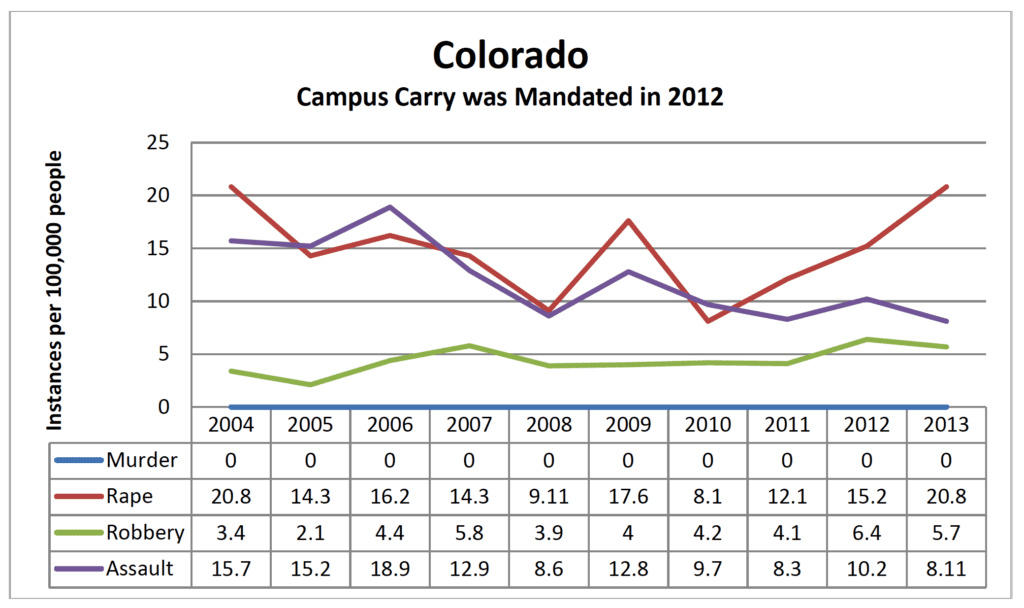
Chart 1a – Colorado Campus Crime Statistics 2004-2013
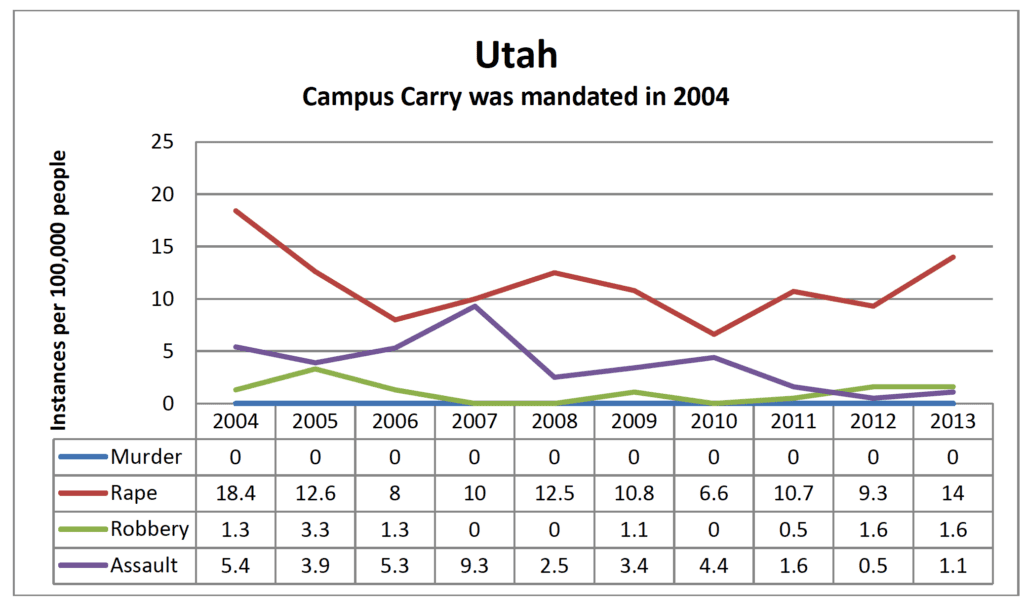
Chart 1b – Utah Campus Crime Statistics 2004-2013
Crime rates on campus carry states versus state crime rates in the respective states
The following two informative charts illustrate crime trends on and off campus in states that permit concealed handguns on campus. Chart 2 compares the campus crime data in Utah verses crime data for the state of Utah. The Clery data was removed from the state FBI data to ensure no duplication of reports. The state homicide rate remained somewhat constant, while forcible rape, robbery, and aggravated assault gradually decreased over the ten-year period. Forcible rape on campus, however, began to decrease, remained steady, and then rose sharply over the last four years. Robbery remained somewhat constant while aggravated assault decreased over the ten-year period. The noticeable comparison between state and campus crime statistics occurs in the category of forcible rape as the state rate gradually decreased while the campus rate increased.
CHART 2 – Utah Campus Crime versus State Crime. Numbers are instances per 100,000 people.
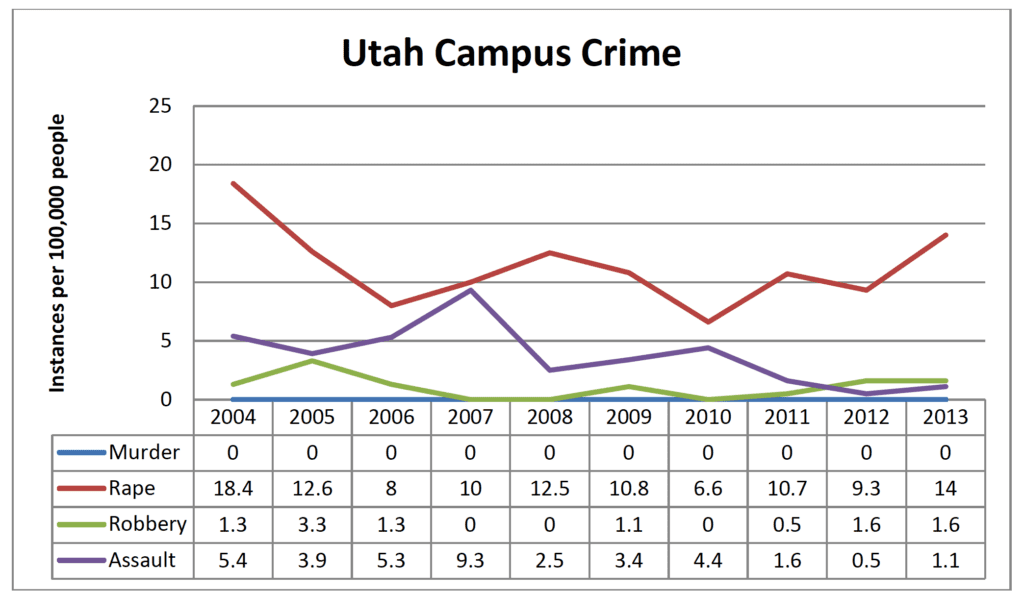
Chart 2a – Utah Campus Crime Rates 2004-2013
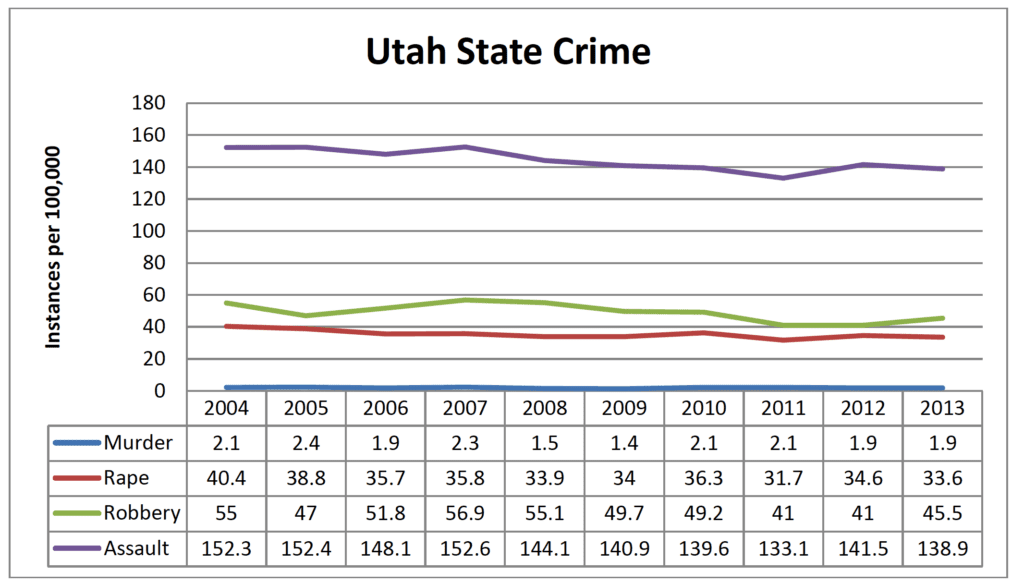
Chart 2b – Utah State Crime Statistics 2004-2013
Chart 3 compares the campus crime data in Colorado versus the state of Colorado. Again, the Clery data was removed from the FBI data to ensure no duplication of reports. The state homicide and forcible rape statistics remained somewhat constant, while robbery and aggravated assault decreased slightly over the ten-year period. Because the concealed carry law was mandated in 2012, only two years of data exist. Similar to Utah, campus forcible rape, over a ten-year period, began to decreased, remained steady, and then drastically increased over the past four years. Robbery and aggravated assault decreased slightly. The noticeable comparison between state and campus crime in Colorado is that while forcible rape remained somewhat constant over the ten-year period throughout the state, it rose drastically on campus. Robbery and aggravated assault decreased gradually both on campus and throughout the state.
CHART 3 – Colorado Campus Crime versus State Crime. Numbers are instances per 100,000 people.
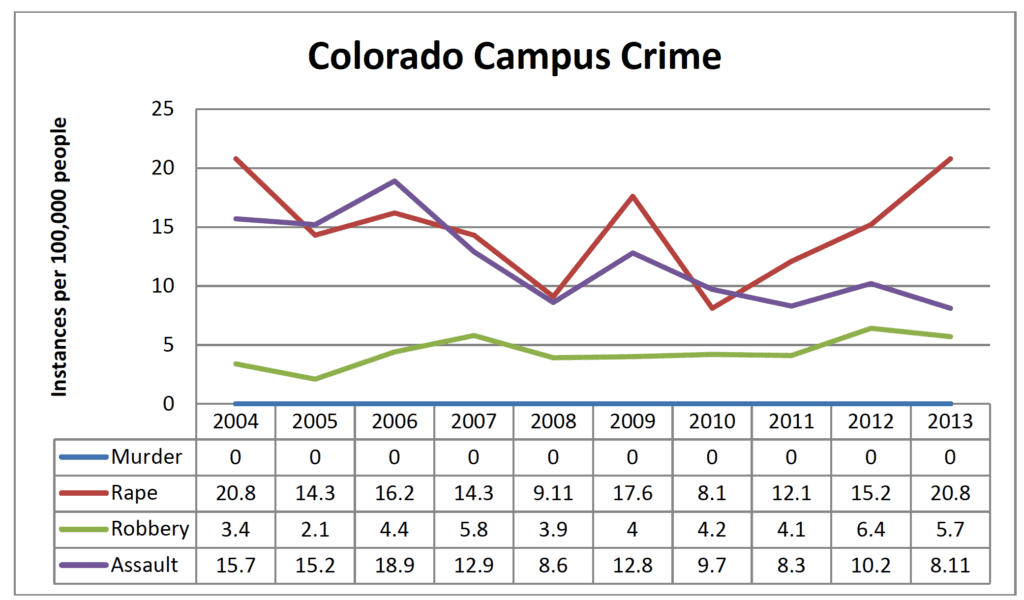
Chart 3a – Colorado Campus Crime 2004-2013
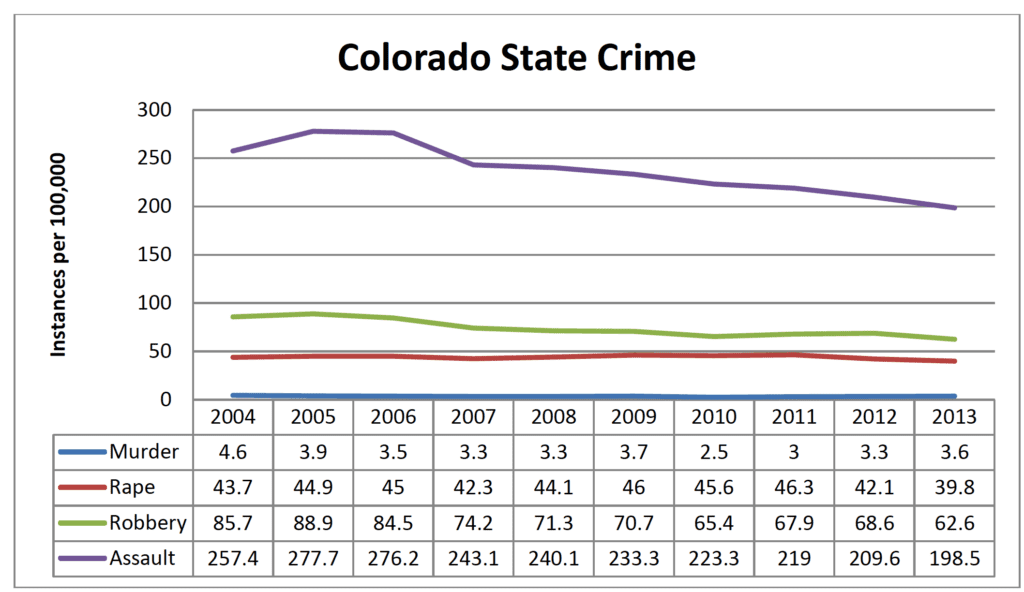
Chart 3b – Colorado State Crime 2004-2013
Crime rates on campus carry states versus crime rates on non-campus carry states
Chart 4 illustrates the differences between campus carry versus non-campus carry states. Ultimately if “more guns equals less crime” then by nature, the occurrence of violent crime should decrease at a greater rate. This chart shows that there is no statistical evidence of this. For example, as illustrated in Chart 2 and Chart 3, forcible rape on campus drastically increased, much faster than the average on non-campus carry states.
CHART 4 – Campus Carry States (Utah & Colorado) Versus National Crime Statistics. Numbers are instances per 100,000 people.
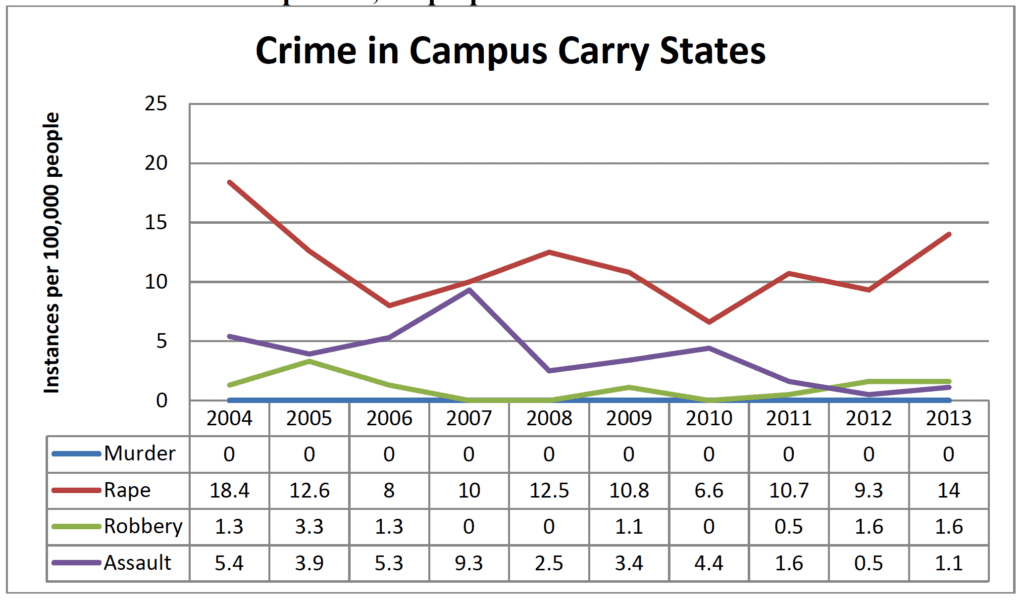
Chart 4a – Crime in Campus Carry States. Utah from 2004-2011 and Colorado and Utah from 2012-2013

Chart 4b – Crime on Non-Campus Carry States. Utah was subtracted from the data from 2004-2011 and Colorado and Utah were subtracted from 2012-2013.
Rate of forcible rape in the nation versus campus carry states versus non-campus carry states
Finally, Table 1 takes the category of forcible rape and compares the fluctuation of rates by percentage nationally (non-campus), in non-campus carry, and in campus carry states. It is extremely important to note that the national average of forcible rape is slowly decreasing every year while non-campus carry states are increasing. The campus-carry states, on the other hand, are increasing at a much faster rate than non-campus carry states.
TABLE 1 – Sexual Assault Percentage Difference over a Ten-Year Period – Nationally (Non-Campus), Non-Campus Carry States, and Campus Carry States (Utah and Colorado).
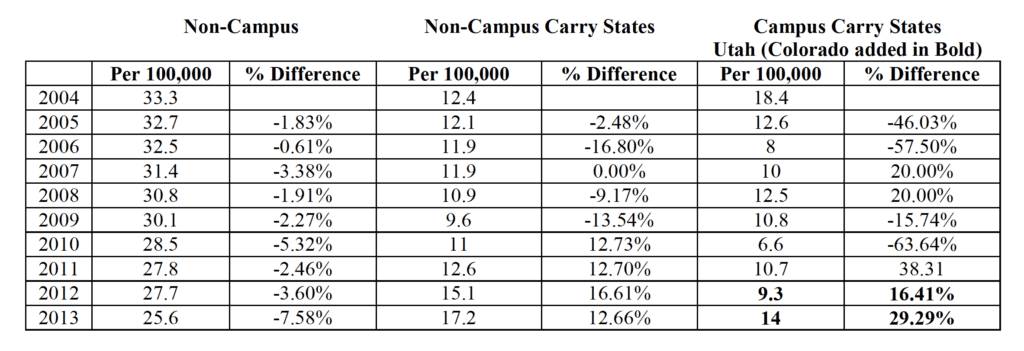
DISCUSSION
While the results certainly do not prove that campus carry causes more crime; it undoubtedly disproves the claim that the possible presence of individuals carrying concealed weapons equals less crime. Idaho is the third state to force state colleges and universities to allow the concealed carry of handguns among its students, faculty, and staff. Idaho was not included in this study because the law was implemented in 2014 and at the time of this study, colleges and universities have only been required to report crime up to 2013. It is also important to understand that this is a small sample size. Finally, it is important to note that the data used came from years prior to the implementation of the Violence against Women Act (2013), which caused a spike in reportage of crime on campus beginning in 2014. The FBI and Clery violent crime statistics presented illustrate that there is no evidence that more guns equals less crime on campus, therefore disproving the notion that campuses that allow concealed weapons are safer than campuses that ban them.
About the Author
The author is a PhD Candidate in Humanities – History of Ideas at The University of Texas at Dallas and the Southwestern Director of the Campaign to Keep Guns off Campus, a non-profit organization focusing on gun violence prevention on campus, building state coalitions, education, and fighting legislation that would permit concealed weapons on campus.
Contributors
Stephen K. Boss, PhD from the University of Arkansas – Fayettville and John M. Marazita, PhD from Ohio Dominican University, reviewed the above study.
Acknowledgements
The research was supported by the Campaign to Keep Guns off Campus. I would also like to thank the President and Founder of the Campaign to Keep Guns off Campus, Andy Pelosi, for his trust and encouragement in this project.
End Notes
1 Lott, John More Guns, Less Crime. Chicago: University of Chicago Press, 1998.
2 Clifton B. Parker “Right-to-Carry Gun Laws Linked to More Violent Crime, Stanford Study Shows,” Stanford News, November 14, 2014. www.news.stanford.edu/news/2014/november/donohue-guns-study-111414.html
3 Charles D. Phillips, Obioma Nwaiwu, Szu-hsuan Lin, Rachel Edwards, Sara Imanpour, and Robert Ohsfeldt, “Concealed Handgun Licensing and Crime in Four States,” Journal of Criminology, vol. 2015, Article ID 803742, 8 pages, 2015. doi:10.1155/2015/803742
4 Department of Education, Clery Annual Campus Security Report, http://ope.ed.gov/security/
5 Department of Education, Clery Annual Campus Security Report, http://ope.ed.gov/security/
6 Federal Bureau of Investigation’s Uniform Crime Reports, http://www.ucrdatatool.gov/
7 Federal Bureau of Investigation’s Uniform Crime Reports, http://www.ucrdatatool.gov/
8 Colorado schools include: Adams State University, Arapahoe Community College, Colorado Mesa University, Colorado Mountain College, Colorado Northwestern Community College, Colorado School of the Mines, Colorado State University-Fort Collins, Colorado State University-Pueblo, Community College of Aurora, Community College of Denver, Fort Lewis College, Front Range Community College, Lamar Community College, Metropolitan State University of Denver, Morgan Community College, Northeastern Junior College, Otero Junior College, Pikes Peak Community College, Pueblo Community College, Red Rocks Community College, Trinidad State Junior College, University of Colorado-Boulder, University of Colorado-Colorado Springs, University of Colorado-Denver, University of Northern Colorado, Western State Colorado University.
9 Utah schools include: Bridgerland Applied Technology College, Davis Applied Technology College, Dixie State College of Utah, Ogden-Weber Applied Technology College, Salt Lake Community College, Salt Lake Community College – Skills Center, Snow College, Southern Utah University, Uintah Basin Applied Technology College, University of Utah, Utah State University, Utah State University-College of Eastern Utah, Utah State University – Regional Campuses and Distance Learning, Utah Valley University, Weber State University.
